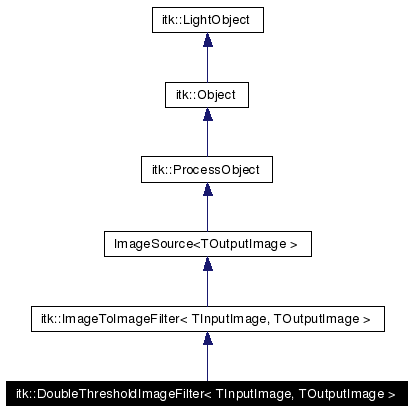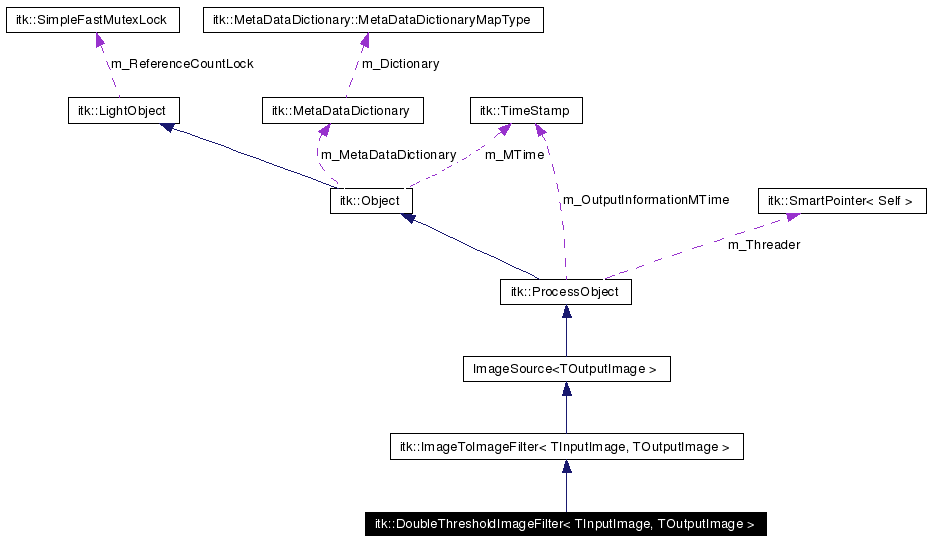Main Page
Groups
Namespace List
Class Hierarchy
Alphabetical List
Compound List
File
List
Namespace Members
Compound Members
File Members
Concepts
Binarize an input image using double thresholding.
More...
#include <itkDoubleThresholdImageFilter.h>
Inheritance diagram for itk::DoubleThresholdImageFilter< TInputImage, TOutputImage >:
 [legend]Collaboration diagram for itk::DoubleThresholdImageFilter< TInputImage, TOutputImage >:
[legend]Collaboration diagram for itk::DoubleThresholdImageFilter< TInputImage, TOutputImage >: [legend]List of all members.
[legend]List of all members.
Detailed Description
template<class TInputImage, class TOutputImage>
class itk::DoubleThresholdImageFilter< TInputImage, TOutputImage >
Binarize an input image using double thresholding.
Double threshold addresses the difficulty in selecting a threshold that will select the objects of interest without selecting extraneous objects. Double threshold considers two threshold ranges: a narrow range and a wide range (where the wide range encompasses the narrow range). If the wide range was used for a traditional threshold (where values inside the range map to the foreground and values outside the range map to the background), many extraneous pixels may survive the threshold operation. If the narrow range was used for a traditional threshold, then too few pixels may survive the threshold.
Double threshold uses the narrow threshold image as a marker image and the wide threshold image as a mask image in the geodesic dilation. Essentially, the marker image (narrow threshold) is dilated but constrained to lie within the mask image (wide threshold). Thus, only the objects of interest (those pixels that survived the narrow threshold) are extracted but the those objects appear in the final image as they would have if the wide threshold was used.
- See also:
- GrayscaleGeodesicDilateImageFilter
MorphologyImageFilter, GrayscaleDilateImageFilter, GrayscaleFunctionDilateImageFilter, BinaryDilateImageFilter
Definition at line 54 of file itkDoubleThresholdImageFilter.h.
Member Typedef Documentation
Member Enumeration Documentation
|
template<class TInputImage, class TOutputImage> |
| anonymous enum
|
|
Constructor & Destructor Documentation
Member Function Documentation
|
|
Set/Get whether the connected components are defined strictly by face connectivity or by face+edge+vertex connectivity. Default is FullyConnectedOff. For objects that are 1 pixel wide, use FullyConnectedOn. |
|
|
Set/Get whether the connected components are defined strictly by face connectivity or by face+edge+vertex connectivity. Default is FullyConnectedOff. For objects that are 1 pixel wide, use FullyConnectedOn. |
|
template<class TInputImage, class TOutputImage> |
| void itk::DoubleThresholdImageFilter< TInputImage, TOutputImage >::GenerateInputRequestedRegion |
( |
|
) |
[protected, virtual] |
|
|
template<class TInputImage, class TOutputImage> |
| virtual const bool& itk::DoubleThresholdImageFilter< TInputImage, TOutputImage >::GetFullyConnected |
( |
|
) |
[virtual] |
|
|
|
Set/Get whether the connected components are defined strictly by face connectivity or by face+edge+vertex connectivity. Default is FullyConnectedOff. For objects that are 1 pixel wide, use FullyConnectedOn. |
|
|
Get the "inside" pixel value. |
|
template<class TInputImage, class TOutputImage> |
| virtual const char* itk::DoubleThresholdImageFilter< TInputImage, TOutputImage >::GetNameOfClass |
( |
|
) |
const [virtual] |
|
|
template<class TInputImage, class TOutputImage> |
| unsigned long itk::DoubleThresholdImageFilter< TInputImage, TOutputImage >::GetNumberOfIterationsUsed |
( |
|
) |
[inline] |
|
|
|
- Deprecated:
- Get the number of iterations used by the geodesic dilation to produce the current output. This method is scheduled for removal since the implementation now uses a noniterative solution.
Definition at line 117 of file itkDoubleThresholdImageFilter.h. |
|
|
Get the "outside" pixel value. |
|
|
Get the threshold values. |
|
|
Get the threshold values. |
|
|
Get the threshold values. |
|
|
Get the threshold values. |
|
|
Method for creation through the object factory.
Reimplemented from itk::Object. |
|
template<class TInputImage, class TOutputImage> |
| void itk::DoubleThresholdImageFilter< TInputImage, TOutputImage >::PrintSelf |
( |
std::ostream & |
os, |
|
|
Indent |
indent |
|
) |
const [protected, virtual] |
|
|
template<class TInputImage, class TOutputImage> |
| virtual void itk::DoubleThresholdImageFilter< TInputImage, TOutputImage >::SetFullyConnected |
( |
bool |
_arg |
) |
[virtual] |
|
|
|
Set/Get whether the connected components are defined strictly by face connectivity or by face+edge+vertex connectivity. Default is FullyConnectedOff. For objects that are 1 pixel wide, use FullyConnectedOn. |
|
|
Set the "inside" pixel value. The default value NumericTraits<OutputPixelType>::max() |
|
|
Set the "outside" pixel value. The default value NumericTraits<OutputPixelType>::Zero. |
|
|
Set the thresholds. Four thresholds should be specified. The two lower thresholds default to NumericTraits<InputPixelType>::NonpositiveMin(). The two upper thresholds default NumericTraits<InputPixelType>::max. Threshold1 <= Threshold2 <= Threshold3 <= Threshold4. |
|
|
Set the thresholds. Four thresholds should be specified. The two lower thresholds default to NumericTraits<InputPixelType>::NonpositiveMin(). The two upper thresholds default NumericTraits<InputPixelType>::max. Threshold1 <= Threshold2 <= Threshold3 <= Threshold4. |
|
|
Set the thresholds. Four thresholds should be specified. The two lower thresholds default to NumericTraits<InputPixelType>::NonpositiveMin(). The two upper thresholds default NumericTraits<InputPixelType>::max. Threshold1 <= Threshold2 <= Threshold3 <= Threshold4. |
|
|
Set the thresholds. Four thresholds should be specified. The two lower thresholds default to NumericTraits<InputPixelType>::NonpositiveMin(). The two upper thresholds default NumericTraits<InputPixelType>::max. Threshold1 <= Threshold2 <= Threshold3 <= Threshold4. |
The documentation for this class was generated from the following file:
Generated at Thu May 25 00:49:15 2006 for ITK by  1.3.5 written by Dimitri van Heesch,
© 1997-2000
1.3.5 written by Dimitri van Heesch,
© 1997-2000



 1.3.5 written by Dimitri van Heesch,
© 1997-2000
1.3.5 written by Dimitri van Heesch,
© 1997-2000